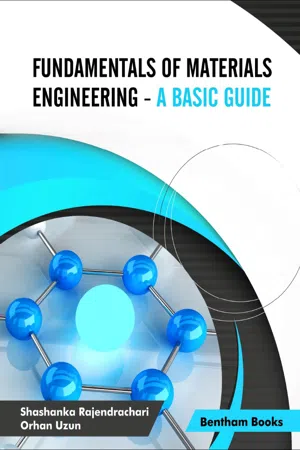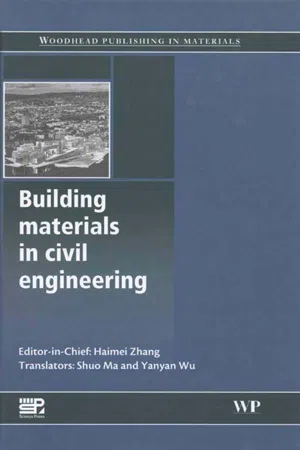Technology & Engineering
Materials Fundamentals
Materials fundamentals encompass the basic principles and properties of materials, including their structure, composition, and behavior. This field explores the relationship between the atomic and molecular structure of materials and their macroscopic properties, such as strength, conductivity, and durability. Understanding materials fundamentals is essential for designing and engineering new materials for various technological applications.
Written by Perlego with AI-assistance
Related key terms
Related key terms
1 of 4
Related key terms
1 of 3
6 Key excerpts on "Materials Fundamentals"
- Shashanka Rajendrachari, Orhan Uzun(Authors)
- 2021(Publication Date)
- Bentham Science Publishers(Publisher)
The materials science and engineering are relatively an interdisciplinary subject connected to chemistry, biology, physics and different areas of engineering. To become a material scientist one should have a minimum bachelor's degree in materials science.4. LEARNING OBJECTIVES
- To learn about the microstructural features of materials and to identify different material groups based on their microstructural features.
- To understand the different types of bonding and arrangement of atoms in crystalline structures.
- To understand the imperfections in materials and the role of these imperfections on the material’s properties.
- To learn about the basic principles of different strengthening mechanisms used to improve the strength of materials.
- To learn about the mechanical properties of materials and the testing methods employed to measure these properties.
- To understand the stress-strain curves and their terminologies.
- To learn the basics of polymers, their types, properties, and applications.
- To understand the mechanism of polymer reactions, methods involved to process polymers.
- To learn about the basic principles of powder metallurgy, methods of preparation, properties, and the applications.
- To understand the mechanism of sintering and advantages of powder metallurgy.
- To learn the basic principles of corrosion, types of corrosion, mechanism of corrosion and corrosion control methods.
- To learn the fundamentals of composite materials, types, properties and applications of composite materials.
CONCLUSION
The material engineering is an interdisciplinary subject, which deals with the study of the structure, properties and applications of different materials. Each material has different properties based upon their structures. Some of the examples for materials include polymers, ceramics, metals, alloys, composites, nanomaterials, etc. These materials are used almost everywhere. Literally everything is made up of materials and this world is materialistic.REFERENCES
[1] Bibikov Sergey, Prokof'Ev Mikhail, Cuppoletti John. Composite Materials for Some Radiophysics Applications, Metal, Ceramic and Polymeric Composites for Various UsesIntechOpen2011July 20th - Alting(Author)
- 2020(Publication Date)
- CRC Press(Publisher)
2Properties of Engineering Materials2.1 INTRODUCTION
For engineers to be able to select a suitable material fulfilling the functional requirements of a component (determined from the performance and economical production requirements), they must have a broad knowledge of:The properties of the materials available The manufacturing possibilities, including: The suitability of the materials for the various processes (i.e., the important properties affecting processing) The effects of the various processes on the material properties The economics of the various material-process combinationsOnly by considering these relationships coherently can a satisfactory selection be made. This means that it is not sufficient to choose the cheapest material that would satisfactorily perform the functions desired, because it may be very ex pensive to process. The functional properties of a material can be evaluated only when the manufacturing processes have been selected, as the processes normally change the properties. Certain mechanical, physical, and metallurgical changes are generally brought about; some beneficial and others detrimental. This change in properties may sometimes allow the choice of a cheaper material than if the functional requirements alone were considered.2.2 MATERIAL PROPERTIES
The properties of materials may be divided into the following four groups: 1.Physical properties 2.Chemical properties 3.Mechanical properties 4.Manufacturing propertiesPhysical properties include color, density, melting point, freezing point, specific heat, heat of fusion, thermal conductivity, thermal expansion, electrical conductivity, magnetic properties, and so on.Of the chemical properties- eBook - ePub
Engineering Textiles
Integrating the Design and Manufacture of Textile Products
- Yehia Elmogahzy(Author)
- 2019(Publication Date)
- Woodhead Publishing(Publisher)
7Material selection
Abstract
Material selection represents the most critical aspect of design engineering. Understanding material structure, properties, and processing represents a common knowledge base between scientists, engineers, and technologists. Many design problems are solved either by selecting raw materials of better attributes or by changing the type of material used. The fact that material can be stiff, strong, ductile, brittle, tough, or hard provides numerous design options that are suitable for a wide range of end products. Since raw material makes up the building blocks of all manufacturing processes, the choice of one raw material versus another could mean substantial cost reduction. This point is very common in textile technology in which manufacturing cost is often minimized by the choice of an appropriate fiber type or blending fibers of different prices at predetermined ratios and under quality constraints. In this chapter, basic steps of material selection in design applications are discussed. The key tasks of evaluating material candidates for a certain product are reviewed. These include (a) knowledge of the common material categories (i.e., screening category), (b) understanding basic material properties (i.e., screening property), (c) determining the optimum cost of material with respect to its performance and its contribution to the value of the end product, (d) understanding the effects of technology on material selection, and (e) understanding the differences between design-direct and value-impact performance characteristics. Many examples of fibrous materials are presented in the context of these tasks. - eBook - ePub
Thermoplastic Material Selection
A Practical Guide
- Eric R. Larson(Author)
- 2015(Publication Date)
- William Andrew(Publisher)
To use thermoplastic materials effectively, one must understand not only their unique behavior, but how that behavior is affected over a broad span of conditions—not just the environmental conditions in the end-use application, but also the processing conditions the resin itself has gone through. To help develop that understanding, we need to start with a review of some basic fundamentals of materials science. More than just discussing some theoretical concepts, we need to appreciate the interconnected nature of material structure, property data, processing, and end-use performance. And in the case of thermoplastics, we also need to review some of the fundamentals of polymer science.This chapter is not intended to be a substitute for a comprehensive training program in materials science or plastics engineering. Rather, it is intended to highlight some key issues, in order to bring some clarity to the complex world of thermoplastic material selection.3.2. Materials Science
Materials science is an interdisciplinary field, involving aspects of physics, chemistry, mathematics, even thermodynamics. It has its origin in the use and processing of metals. One of the fundamentals of material science is that the physical properties of a material are related to its atomic structure. The field has been helped, and been driven by, the development of new materials, including plastics.3.2.1. Strength of Materials
Physical properties of a material include mechanical properties, electrical properties, thermal properties, and more. The mechanical properties of a material deal with how it responds to physical forces. Compared to other materials, thermoplastics respond to force in unique ways.The most basic physical property has to due with the concept of strength. In engineering terms, the strength of a material is its ability to withstand an applied force without failure. Force is a term from classical mechanics, and is a vector, meaning both magnitude and direction are involved. In materials science, strength is quantified on a force per unit area basis. Also known as load, or stress, the forces can be applied in tension (the material is being pulled), compression (the material is being pushed), bending, torsion (twisting), or shear (loads in the same plane as a cross-section of the material) (Figure 3.1 ).Regardless of the type of load, as the load is applied, the material will alter its shape, or deform. This deformation may be temporary, that is the material will return to its original shape when the load is removed, or it may be permanent. Temporary deformations are referred to as elastic deformation, and permanent deformations are referred to as plastic deformation (or failure, depending on their severity). Most materials, including steel, can experience both elastic and plastic deformation. The deformation itself is measured on a percentage basis, and is known as strain. While the deformation of different-sized objects will be different, the stress versus strain behavior of a given material is predictable and repeatable. - eBook - ePub
- Michelle Addington, Daniel Schodek(Authors)
- 2012(Publication Date)
- Routledge(Publisher)
problem-solving characteristics of the nearly 300 000 materials readily available to the engineer (steel alone has over 2000 varieties). Rather than the hierarchical organization of the material scientist, the engineering classification is one of mapping, enabling the engineer to mix and match properties and attributes to best solve the problem or need at hand. Materials in the engineering realm are chosen based on what they can do, how they behave and what they can withstand. The physical criteria for the use are first determined, and a material is selected or engineered to provide the best fit or, at the very least, the most acceptable compromise for the specific criteria. If the material science classification describes how a material is composed, then the engineering classification explains what it does. Furthermore, since the focus is always a practical one, i.e. the material will be used in a product or process, many of the categories are quite pragmatic. For example, an important category is the environment of the application: can the material function in a corrosive atmosphere, can it withstand being submerged in sea water? Still other engineering classifications might include cost, availability, or recyclability as categories of equal importance to the more basic descriptive ones such as state and composition. Even though the final objective in all engineering applications is the optimization of a material property for a particular situation, regardless of the material type, the additional criteria will quickly narrow down the seemingly endless choices. Many industries have developed their own classification systems to help narrow down the choice of materials to those that are appropriate for their own uses. For example, the American Iron and Steel Institute, which deals only with ferrous materials, adopted a straightforward numbering system that encompasses alloy composition, carbon content and processing method. The American Welding Association is even more specific, categorizing electrode materials by tensile strength, welding technique and position. Regardless of the source of the classification system, each one clearly highlights properties that underpin the useful behavior of the material.Figure 2-2 This classification system for materials is typical of those used in applied engineering. It readily mixes the form of material structures (e.g., laminates, amorphous) with properties (ferrous, nonferrous), but can be very useful for many applications. It is difficult to use this kind of classification, however, to describe smart materials with property-changing or energy-exchanging characteristics. (Diagram modeled after Fig. 31-9 in Myer P. Kutz (ed.), The Mechanical Engineer's Handbook - eBook - ePub
- Haimei Zhang(Author)
- 2011(Publication Date)
- Woodhead Publishing(Publisher)
2The Basic Properties of Building Materials
This chapter discusses the components, the structures of materials and the influence of their compositions on the properties; it emphasizes on the physical properties and the mechanical properties of materials; and also it introduces the decorativeness and the durability of materials.In the civil engineering, building materials plays different roles, so they should possess corresponding properties. For example, structural materials should have good mechanical characteristics; waterproof materials should be impermeable and water-resistant; wall materials should be heat-insulating and sound-absorbing. In addition, building materials should be durable because they often affected by various external factors, such as wind, rain, sun and frost.The basic properties of building materials include physical property, mechanical property, durability and decorativeness. The commonness of the properties is discussed in this chapter and their specialties will be discussed in relevant chapters.2.1 Compositions and Structures of Materials and the Influence of Their Constructions on the Properties
2.1.1 The Compositions of Materials
The compositions of materials include chemical compositions and mineral compositions which are the key factors for the properties of materials.1 Chemical Composition
The chemical composition refers to the chemical constituents. Various chemical compositions result in different properties. For example, with the increase of carbon content, the strength, hardness and toughness of carbon steel will change; carbon steel is easy to rust, so stainless steel comes into being by adding chromium, nickel and other chemical components into steel.2 Mineral Composition
Many inorganic non-metallic materials consist of a variety of mineral compositions. Minerals are monomers and compounds with a certain chemical components and structures. The mineral compositions are the key factors for the properties of some building materials (such as natural stone, inorganic gel and other materials). Cement reveals different characteristics because of different clinkers. For example, in Portland cement clinkers, the condensation hardening is fast and the strength is high when the content of tricalcium silicate—the clinker mineral—is high.
Index pages curate the most relevant extracts from our library of academic textbooks. They’ve been created using an in-house natural language model (NLM), each adding context and meaning to key research topics.
Explore more topic indexes
Explore more topic indexes
1 of 6
Explore more topic indexes
1 of 4





